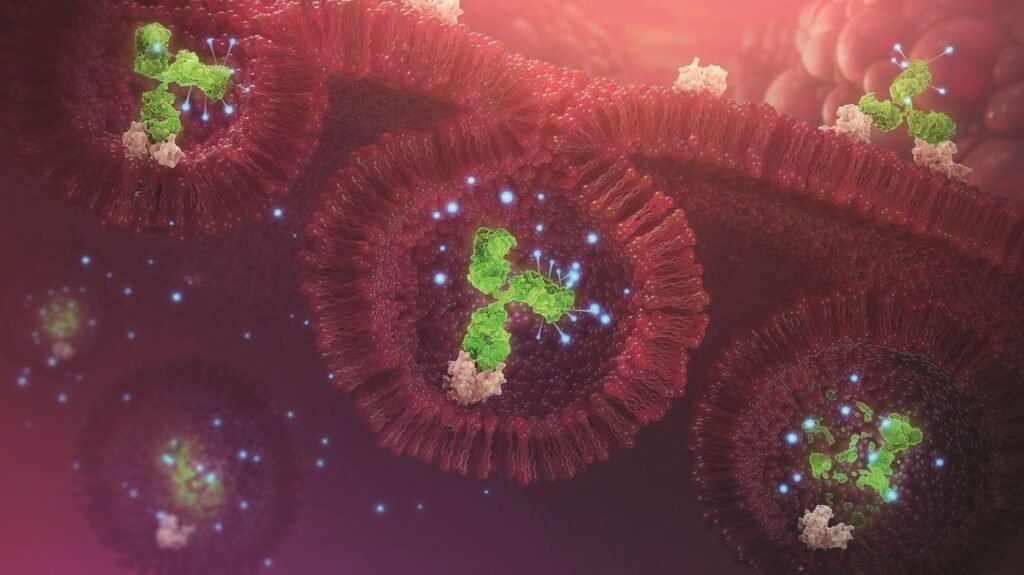By 2030, the market for antibody drug conjugates is anticipated to have grown from its present value of $4 billion, which it had in 2021, to $13.1 billion, with a CAGR of 14.12%. North America is anticipated to dominate the market with a projected 37% share, followed by Europe.
In order to achieve targeted application, prodrugs or drugs are covalently joined to organic or synthetic molecular transporters such proteins, lipids, carbohydrates and polymers. Conjugation is now a crucial method for drug release and targeted drug delivery thanks to tiny molecules and biotherapeutic techniques such protein-drug coupling, antibody-drug acylation, polymer-drug acylation, and T-cell dual affinity re-targeting recombination. Conjugating drugs to carriers can improve drug stability, pharmacokinetics, and pharmacodynamic properties while altering toxicity profiles. Known as a targeted therapy for treating and curing cancer, ADCs are a group of biopharmaceutical drugs. In contrast to chemotherapy, ADCs are used to target and kill cancer cells while sparing healthy cells.
Different cancer treatments based on antibodies
Antibodies are used in the treatment to aid the body’s defences against cancer, infection, or other disorders. Immune system-produced proteins called antibodies bind to particular markers on cells or tissues. One of the effective therapeutic approaches in recent years has been cancer therapy based on antibodies.
- Immune checkpoint inhibitors (ICIs): They prevent partner proteins of checkpoint proteins from tying up with one other.
- Angiogenesis inhibitors prevent the development of blood vessels that facilitate the growth of tumours.
- Multi-specific antibody therapy: This kills tumour cells more accurately and successfully by targeting numerous tumour antigens.
- Chimeric antigen receptor T (CAR-T) cells therapy: T cells, a subset of the immune system, are modified in the lab to target cancer cells.
- Antibody drug conjugates (ADCs): By chemically bonding a monoclonal antibody that is chemically coupled to a drug, ADCs deliver therapeutics to cancer cells only.
- ADC components include: A drug-antibody conjugate consists of three parts:
- A therapeutic response may also be elicited by the antibody, which targets the ADC.
- The intended therapeutic response is the payload.
- Linker: It increases circulatory stability and allows for targeted payload release in the target tissue.
A chemical linker in ADCs combines monoclonal antibodies that are directed against surface antigens discovered on certain tumour cells with very powerful anti-cancer medications. Since it links the antibody to the cytotoxic payload, the linker is an essential part of how ADCs work.
Market Dynamics
Drivers (Increasing pervasiveness of cancer, Higher Occurrence of breast cancer, Growing preference for Antibody-based Cancer therapies, Technological advancements , Significant risk in old age, Rise in an obese population and Greater clinical trials and research trials).
Drivers of the market for antibody drug conjugates include:
- Cancer is becoming more common as individuals age, most likely because some tumours are more likely to develop as people age. As a person matures, cellular repair mechanisms become less efficient, which increases the danger. The demand for ADCs is being pulled down by the rising cancer incidence. According to GLOBOCAN 2020, there were approximately 10.0 million cancer deaths and 19.3 million new cases of cancer globally in 2020.
- High Breast Cancer Incidence: The majority of authorised ADCs are used for patients with breast cancer. Age, obesity, risky alcohol use, radiation exposure history, family history of breast cancer, reproductive history (age at first menstrual cycle and age at first pregnancy), and cigarette use are all risk factors for breast cancer. According to the American Cancer Society’s cancer statistics, breast cancer has the greatest incidence and the second-highest overall fatality rate among women in the United States.
- High need for antibody-based cancer therapeutic strategies: Due to its numerous modes of action, including natural characteristics, engagement of cytotoxic T cells, and delivery of cytotoxic payloads, several antibody-based cancer therapies are in high demand. Immune checkpoint modulators, antibody-drug conjugates (ADCs), and bispecific antibodies are now progressively dominating the commercial clinical pipeline of cancer medicines, claims an article in the Antibody-drug Society. Approximately 20% of the clinical pipeline of antibodies for cancer are antibody-drug conjugates (ADCs).
- Technological developments: The first-generation ADCs’ limited success (developed in the early 2000s) opened the door for the second-generation ADCs (released starting in 2010), which have higher levels of cytotoxic drug conjugation, lower levels of naked antibodies, and more stable linkers between the drug and the antibody. Third-generation ADCs (available starting in 2019) use site-specific conjugation techniques rather than random coupling, allowing for precise control of payload conjugation to produce a homogeneous result.
- Greater risk in old age: The greatest significant risk factor for cancer and many specific cancer types is advancing age. Age-related increases in cancer risk are exponential. About 60% of malignancies affect persons 65 years of age or older, according to data published in NCBI. Additionally, this stage is where around 70% of cancer-related deaths occur.
- An increase in the number of obese people has been associated with worsening quality of life, cancer recurrence, cancer progression, prognosis (survival), and the possibility of some “second primary malignancies.” Most research on obesity in cancer survivors involves those who have had colorectal, prostate, or breast cancer. The National Health And Nutrition Examination Survey (NHANES) found that 42.4% of adults are obese, 42.4% of adults are overweight, and 9.2% of adults have severe obesity.
- ADCs have developed into a significant class of anti-cancer medications, with a sharp rise in the number of ADCs being studied in clinical trials for the treatment of solid tumours and hematologic malignancies during the past five years. Nearly 60% (7 out of 12) of ADCs have received FDA approval in the last three years alone, according to NCBI, demonstrating that as ADC technology matures, more positive clinical outcomes follow. Polivy (2019), Padcev (2019), EnHertu (2019), Trodelvy (2020), Blenrep (2020), Zynlonta (2021), and Tivdak are some of the most recent ADCs to be approved (2021).
Restraints
- FDA requirements for medication approval are strict: To obtain FDA approval to launch a novel prescription drug, a pharmaceutical company must follow a five-step process that includes discovery/concept, preclinical research, clinical research, FDA review, and FDA post-market safety monitoring. The FDA approval procedure is complicated and time-consuming for pharmaceuticals (9 to 12 years) and devices, according to the FDA Review Project (7 years).
- ADCs have a reasonable side-effect profile due to their high selectivity, with nausea and vomiting being the most frequent toxicities. This changes, nevertheless, according to the ADC and the supplementary payload. Other side effects include stomatitis, vomiting, infection, fever, and nausea. Low blood counts, liver damage, including hepatic veno-occlusive disease, infusion-related reactions (IRRs), and bleeding are among these significant adverse effects.
Opportunities
In 2021, the agency’s Center for Drug Evaluation and Research (CDER) approved 50 innovative treatments, representing an increase in product launches and approvals. In this decade, the FDA approved an average of 51 medications annually, up from 24 in the previous five years. More than 80 ADCs have been studied in various clinical phases from over 600 clinical trials, according to the Science Direct report. The FDA has thus far given its approval to a total of 12 ADCs.
Increasing numbers of seniors: Seniors are more likely to develop some cancers. Breast and colon cancer are two of the most prevalent malignancies, and both can be easily recognised in their early stages and treated. The detection of some tumours, including lung cancer, is more difficult, and their treatment can be more difficult and important. The demand for ADCs is projected to increase as the elderly population grows. Data from the World Bank and World Population Prospects show that the proportion of people 65 and older will increase from 9.32% in 2020 to 16% in 2050. The number of persons 65 and older will double in the next 30 years, while the number of those 80 and older will triple.
Analysis of market segments for antibody drug conjugates globally
Based on Application, Technology, and Region, the sector has been substantially divided.
Using Application
- Breast Cancer
- Obesity cancer
- Mammary Cancer
- Sun Cancer
- Chest cancer
- Brain cancer
- Additional Application
Using technology
- Non-cleavable Linker
- Linker Cleavable
- less links
From Region
North America
- United States of America
- Canada
- North America as a whole
Europe
- Spain
- Germany
- British Empire
- Italy
- Russia
- France
- Europe as a whole
Asia-Pacific
- China
- Japan
- Korea, South
- Australia
- India
- Singapore
- Asia-Pacific as a whole
LAMEA
- Brazil
Argentina



